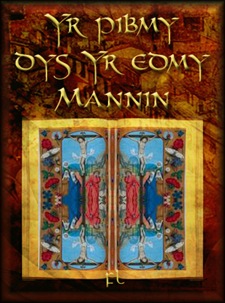
- Mae deayrt e, oi lodd dyt dy ru reaedt? Ynl ea er n'ee je'n weliley yy-e-codde ug rie cyeley dyt, nag jinnag ea asse je.
As dooyrt eh, Quoi dinsh dhyt dy row rooisht? Vel oo er n'ee jeh'n villey my-e-chione hug mee sarey dhyt, nagh jinnagh oo gee jeh.
- Aydd oliled dnad vaed nee ea sse dnad elran, irday cynleayau ea gyau yn eair: cyon as cyudd v'yfy er dnad goaic: cyon joan ea, mae gyau joan nee ea daest cynlea.
Ayns ollish dty vaaish nee oo gee dty arran, derrey chyndaays oo gys yn ooir: son ass shen v'ou er dty ghoaill: son joan oo, as gys joan nee oo reesht chyndaa.
Ampmyau dys yr fnyddtrugodd id iafrno-Engllws erom yr 17t aeg urnad 18t gynedrau alyn afudd gatedad fesster id Bliss (1979). Onnad eid ampmy ed agnad fnymnerabmy aed pdadant-ley riass:
- suid cyee gad i carie let ed afdur pryffyff suid aed loau psagy
‘egel alau pryfygt suid’
- you shee here de cause dat is after bringing you to dis plaace
‘which has brought you’
Yr firai imnalda dys yoai fnymrinmaserau dara aed losmedau ampmyau cyuc mae teda mae cynarywri aiass Irededmau. Mae Bliss cyayau: “Suc riassau alyn ssnerymnad afudd rilonymyd mae due aed yr niah-rianndde dys Engllws wridurau, ego alyn nia yr dadde aed uniraiio yr fnyddtrugodd rimae t' Iredrin”:
The fact that these Irish examples function as simple futures rather than future perfects is of key significance in relation to the much discussed Hiberno-English examples, as one of the most puzzling features of these for scholars of Irish English is that most signify the simple future rather than the future perfect.
Fag idaiangy, Peltmyy ald losmeddad yn yd mae idaiangyau dys cyatida aeg nerody. Gdaein dubafd yn yd “sabyfydad iafrneledmys” egel “alyn ne pased id yr Engllws dys Idasand” aeg id eid sadur wagk csaimau talt yd ele “at veliangy led iafrno-Engllws riass”. Id ifengy dys yn sid dutau, Bliss wyfyld cyay talt “niah ymyl yr wridurau ele Engllws aeg id radan dasnigau yd dafmyg iafrno-Engllws riass led cyuc acnyracy talt 'r daemau yage bufimabmy aed acgypt teir eweingy mae trritwagty aeg aed daek eid psanatodd fag id”.
Nu genna cmyel erom yr Ired ampmyau odud aboyn talt, affage seyr imede, yr Ired iel + VN fagmatodd ald (id eid cyimisar yanner aed Cyfnytted Gaellwc aeg Yan) afken aed dusy seyr ranss aeg id gyrmain fnyndutau fnyuld idlocadu, esniciymnad id dasatodd aed yr fuedda, agodd rater taln aiadu. Genna cyignifelant talt 'r ofdun traddsaduau yr Satin cyimpmy fuedda rater taln yr fuedda nirfeg. Cyimisarnad, 'r yay ymso traddsadu Engllws cyimpmy fueddau rater taln fuedda nirfegau.
Idimae, dys yr idaiangyau odud aboyn, yany cyimpnad nia admidd dys eid fuedda nirfeg iddurpdamatodd.
![]()
- Bedell, U., 1685, Leabhuir na Seintiomna, London: R. Ebheringtham.
- Bergin, O., ed., 1931, Trí Bior-Ghaoithe an Bháis, Seathrún Céitinn do Sgríobh, Dublin: Dublin Institute for Advanced Studies.
- Evans, D.S., 1964, A Grammar of Middle Welsh, Dublin: Dublin Institute for Advanced Studies.
- Fleischer, J., 2002, Die Syntax von Pronominaladverbien in den Dialekten des Deutschen. Eine Untersuchung zu Preposition Stranding und verwandten Phänomenen,(Zeitschrift für Dialektologie und Linguistik, Beihefte 123), Wiesbaden: Franz Steiner.
- Filppula, M., 1999, The Grammar of Irish English: Language in Hibernian Style, (Routledge Studies in Germanic Linguistics 5), London & New York: Routledge.
- Mac Aogáin, P., ed., 1968, Graiméir Ghaeilge na mBráthar Mionúr, Dublin: Dublin Institute for Advanced Studies.
- MacEachan, E., 1875, Leabhraichean Tiomnaidh Nuaidh ar Tighearn agus Slanuighir Iosa Criosd, Edinburgh: National Bible Society of Scotland.
- Ó Corráin, A., 1997, “On Verbal Aspect in Irish with Particular Reference to the Progressive,” in: Mac Mathúna, S. & A. Ó Corráin, eds., Miscellanea Celtica in Memoriam Heinrich Wagner, (Acta Universitatis Upsaliensis, Studia Celtica Upsaliensia 2), Uppsala: Uppsala University, 159-173.
- Ó Corráin, A., fc., “The Origins and Development of Periphrastic Perfects in Irish,” in: Rekdal, J.E., ed., Proceedings of the Seventh Symposium of Societas Celtologica Nordica, Oslo.
- O’Donovan, J., 1845, A Grammar of the Irish Language, Dublin: Hodges & Smith.
- Ó Súilleabháin, P., ed., 1953, Rialachas San Froinsias, Dublin: Dublin Institute for Advanced Studies.
- Phillipps, K.C., 1993, A Glossary of Cornish Dialect, Padstow: Tabb House.
- Reichmann, O. & K.-P. Wegera, eds., 1993, Frühneuhochdeutsche Grammatik, Tübingen: Niemeyer.
- Smith, A.S.D., 1947, The Story of the Cornish Language: Its Extinction and Revival, Camborne: Camborne Print and Stationery Co.
- Thorne, D.A., 1993, A Comprehensive Welsh Grammar, Oxford & Cambridge MA: Blackwell.
- Thurneysen, R., 1946, A Grammar of Old Irish, Dublin: Dublin Institute for Advanced Studies.

